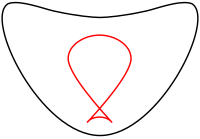Dual curve

Imagine you have a piece of paper with a line drawn on it. This line is like a road that goes from one point to another. Now imagine you draw another line right next to the first one, so that they're touching all the way along. These two lines are like twins, they look almost the same but they're different lines. Now, let's say you do this with a lot of roads on the same piece of paper, so that you have pairs of roads all the way along. This is kind of like having two different curves right next to each other, but they're similar in some way.
When we talk about a dual curve, we mean something similar to this. We have one curve, which is like a road on a piece of paper, and then we draw another curve right next to it, which is like the twin. These two curves are related to each other in a special way. They're kind of like a mirror image of each other, but not exactly the same. One curve can have lots of different twins, depending on how we draw them.
The reason people talk about dual curves is because they help us to understand certain kinds of shapes and objects, and how they relate to each other. It's kind of like having a map that shows us all the different roads or paths we can take to get from one place to another. By looking at the dual curve of a shape, we can see how it's put together, and how all the different parts fit together.
When we talk about a dual curve, we mean something similar to this. We have one curve, which is like a road on a piece of paper, and then we draw another curve right next to it, which is like the twin. These two curves are related to each other in a special way. They're kind of like a mirror image of each other, but not exactly the same. One curve can have lots of different twins, depending on how we draw them.
The reason people talk about dual curves is because they help us to understand certain kinds of shapes and objects, and how they relate to each other. It's kind of like having a map that shows us all the different roads or paths we can take to get from one place to another. By looking at the dual curve of a shape, we can see how it's put together, and how all the different parts fit together.
Related topics others have asked about:
